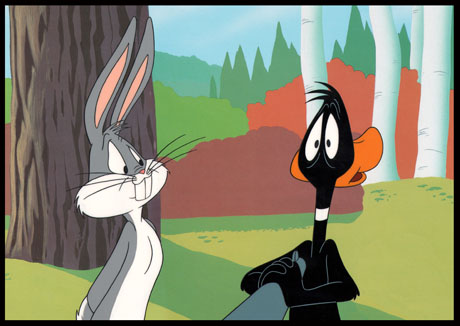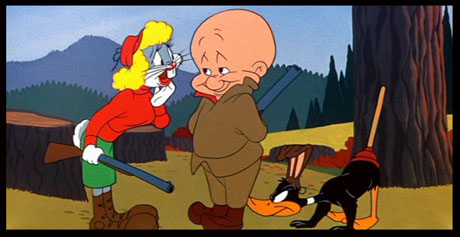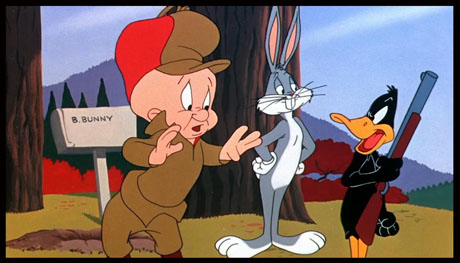Moviegoers have seen some impressive conflicts depicted on screen: Rocky Balboa and Apollo Creed, Luke Skywalker and Darth Vader, The Avengers, and Thanos. But few, if any, reach the heights of Bugs Bunny and Daffy Duck, head-to-head, shouting at one another, while Elmer Fudd stands nearby with his shotgun at the ready.
Rabbit Fire, released on May 19th, 1951, was the first time Bugs, Daffy, and Elmer squared off, starting a feud that’s gained iconic status in animation history.

The short opens with now-familiar animation image and dialogue, as Elmer Fudd makes his way through the forest, shotgun in hand, and turns to the camera to inform the audience, “Be vewy vewy quiet, I’m hunting rabbits.”
Elmer has been following rabbit tracks, which lead to the rabbit hole of “B. Bunny” (as it states on his mailbox). However, the tracks are being made by Daffy Duck, with a pair of fake rabbit feet.
What ensues is Elmer trying to hunt Bugs, Bugs convincing Elmer that he should instead be hunting Daffy, in the now, also iconic “Duck Season! Wabbit Season!” exchange between the two, usually resulting in Daffy getting blasted by the shotgun and his bill in a hilarious and precarious position.
The two also dress up and imitate each other to throw Elmer off. This sequence is even more impressive from a vocal performance standpoint when one realizes that master voice artist Mel Blanc had to provide what Daffy’s voice would sound like if Bugs was doing it and vice versa.

There’s also a sequence in which Bugs dresses in drag (another iconic gag in future shorts) as a female hunter with Daffy as his dog. When Elmer eventually sees through this, Bugs and Daffy begin tearing Rabbit Season and Duck Season posters off a nearby tree, eventually revealing one that reads: “Elmer Season.”
With a vicious glare, the two turn the tables and begin hunting the hunter, ending the short by stating: “Be vewy, vewy quiet. We’re hunting Elmers.”
Rabbit Fire could have only been brought to the screen by the legendary genius of Chuck Jones (billed here as “Charles M. Jones”). Not only does the short have lush, full animation and backgrounds (here by one of his regular partners Philip DeGuard), but the comic timing in Rabbit Fire rivals anything seen in live-action.
Jones not only incorporates memorable sight gags but was also unafraid to slow the animated action down for pauses, which allows us to anticipate the laugh that is about to come and makes the short funnier, no matter how many times you’ve seen it.
An example of this is the scene in which, after getting another round of Elmer’s buckshot to the face, courtesy of Bugs, Daffy takes a few slow steps right up to Bugs’ smirking face before informing him, “You’re despicable.”

Another is when Bugs attempts to get Elmer interested in sports other than hunting, at which point, Daffy emerges, dressed in whites with a racquet in his hand, asking, “Anyone for tennis?” Elmer just shoots him, the smoke clears and reveals a singed Daffy wearily declaring, “Nice game!”
Jones’s innate comic sensibilities are on full display. In his book Chuck Amuck: The Life and Times of An Animated Cartoonist, published in 1989, he discussed why the audience responds to humor, like that in Rabbit Fire: “Every great comedian makes himself available to his audience. That is, the traits that define his personality the audience must be able to recognize in themselves-even though, as, in the case of a Daffy or Bugs, they do not have the courage to exercise them.”
Rabbit Fire was so popular that Bugs, Daffy, and Elmer teamed up again for two more short subjects Rabbit Seasoning (1952) and Duck! Rabbit! Duck! (1953). The cartoons have become affectionately referred to as “The Hunting Trilogy,” as the plots are so similar and, yet, so distinctly funny.

Rabbit Fire marked the first time Bugs and Daffy starred together (Bugs had made a cameo in 1943‘s Porky’s Pig’s Feat, which also starred Daffy), but with Rabbit Fire, they were both the headliners.
Seventy years later, their dynamic together, partnered with Elmer’s gentile cluelessness, has, rightly so, become the stuff of animation legend.
In his book, Hollywood Cartoons: American Animation In Its Golden Age, author and animation historian Michael Barrier summed up the success of Rabbit Fire and the other films of “The Hunting Trilogy” by noting that they succeed “…as aerobatic feats: watching Jones bring Bugs and Daffy through these cartoons whole is like watching circus aerialists perform without a net.”


 Michael Lyons is a freelance writer, specializing in film, television, and pop culture. He is the author of the book, Drawn to Greatness: Disney’s Animation Renaissance, which chronicles the amazing growth at the Disney animation studio in the 1990s. In addition to Animation Scoop and Cartoon Research, he has contributed to Remind Magazine, Cinefantastique, Animation World Network and Disney Magazine. He also writes a blog, Screen Saver: A Retro Review of TV Shows and Movies of Yesteryear and his interviews with a number of animation legends have been featured in several volumes of the books, Walt’s People. You can visit Michael’s web site Words From Lyons at:
Michael Lyons is a freelance writer, specializing in film, television, and pop culture. He is the author of the book, Drawn to Greatness: Disney’s Animation Renaissance, which chronicles the amazing growth at the Disney animation studio in the 1990s. In addition to Animation Scoop and Cartoon Research, he has contributed to Remind Magazine, Cinefantastique, Animation World Network and Disney Magazine. He also writes a blog, Screen Saver: A Retro Review of TV Shows and Movies of Yesteryear and his interviews with a number of animation legends have been featured in several volumes of the books, Walt’s People. You can visit Michael’s web site Words From Lyons at: 






















A case can be made that the first cartoon with Elmer, Bugs and Daffy was “A Corny Concerto” (1943), if one accepts that the black duckling in the second part is really a young Daffy. Even so, the three of them never appear on screen together or interact in any way.
This is a favourite of mine, and of my wife. A lot of people prefer the original wacky Daffy of Clampett and Avery, but that personality wouldn’t have played well against Bugs Bunny. I really like the Jones/Maltese take on the comic chemistry between Bugs and Daffy, not only in the Hunting Trilogy but also in “Ali Baba Bunny”. This dynamic was later adopted by Freleng and McKimson in cartoons like “A Star Is Bored” and “People Are Bunny”. It also formed the core of “The Looney Tunes Show”, although in that instance Bugs was too much of a straight man for my taste.
I love both characterizations of Daffy and think there is room for both! Like you said, his later characterization and pairing with Bugs led to hilarious cartoons. I also love how the two of them play off of each other in “Looney Tunes: Back in Action”.
Chuck Jones pointed out that in these “Hunting Trilogy” cartoons, the characters interact with each other throughout, and the humor is derived from this interaction and from their competing personalities, whereas in the Disney cartoons that team Mickey Mouse, Donald Duck, and Goofy, the characters always separate for the majority of the short and only come together briefly at the end. Given that these Bugs-Daffy outings have this contrast to the Disney output makes them stand out all the more and reveals the true comic genius of Jones.
Honestly, I don’t think it’s a fair comparison between those small series. It’s like comparing “Peter Gunn” to the 1960’s “Batman” series.
Three of the best Looney Tunes shorts! I think my favorite of the three is “Rabbit Fire”. While it doesn’t follow the exact same formula as the other three, “Beanstalk Bunny” is another really good cartoon with the trio of Bugs, Elmer, and Daffy that I recently watched for the first time thanks to Looney Tunes: Collector’s Choice Volume 1.
It has occurred to me that the dynamic between Bugs and Daffy is reminiscent of the Bing Crosby – Bob Hope dynamic in the “Road” pictures: One character is cool, calm, and collected, and the other is frantic and conniving, and they are often as much rivals as partners.
Ironically, considering Chuck Jones’ disparagement of TV animation as “radio with pictures,” these particular cartoons are driven almost entirely by the (admittedly brilliant) dialogue. As someone who used to tape record TV content in pre-VCR days (barely more than a toddler at the time), I can say you can listen to them with no visual and know pretty much what’s going on, but of course you will miss the running gag of what happens to Daffy’s beak every time he gets shot.
One issue with these cartoons is that they mark a turning point in Bugs’ personality, whereafter he becomes less charming and more smug, although he hasn’t quite yet become a man in a rabbit suit. And Daffy has become less zany and more aggressive. Elmer stays relentlessly Elmer.
I think it’s also ironic that modern audiences are much more familiar with the classic Looney Tunes shorts because of their repeated airings on network and basic cable for decades than, say, the classic Disney shorts, which largely didn’t air on TV or were kept behind a pay TV wall.
Yeah, I don’t see any turning point on Bugs.
A very well-done cartoon.
I don’t care for what Jones “did” to Daffy.
Honestly, there was a jealous streak on Daffy early on in Friz’s “You Ought to Be in Pictures” (1940).
No mention whatsoever of Michael Maltese?
Now THAT’S despicable.
After all, he WROTE Rabbit Fire and most of the other Chuck Jones classics.
Jones didn’t do Pepe Le Pew, Road Runner, One Froggy Evening, or Marvin Martian alone either. Maltese had a huge hand in all of them.
Posting my first comment here to say echo exactly this. Chuck’s peak ain’t Chuck’s peak without Mike. This is like writing about “Sgt. Pepper” and saying “boy, that John Lennon sure made a great album!”
Well said, David. Well said.
As a side note, the “Wabbit Season/Duck Season” dialogue is similar in structure to the “Pig/Eagle/Pig” tete-a-tete between Porky and Daffy in Duck Soup To Nuts (1944), where Tedd Pierce got the story credit.
Don Yowp, I know you’re a huge Quick Draw McGraw fan (and aren’t we all?) and we know Mike Maltese wrote EVERY episode and its components Augie Doggy and Snooper & Blabber. That still amazes me, in addition to all his stellar work for the Bugs Bunny factory.
You beat me to it! It’s astounding that anyone could believe that these cartoons, which are essentially talkfests, would be the classics they are without Maltese’ way with words. He may be the single most undervalued person in Golden Age animation, and it’s high time we start giving him his proper due.
I love the Hunting Trilogy. The best was yet to come until Duck, Rabbit, Duck!
I regard “Beanstalk Bunny” (1955) as the fourth cartoon in the Wabbit Season Twilogy.
This cartoon was among the very first cartoons. I saw on color TV, as my house got a color set and I had seen it as one of the first cartoons that I tuned in on. So great! Maybe one day we will actually see it on Blu-ray at its proper pitch, but for now the existing print is wonderful! As far as I know, the last time these three characters were seen in a cartoon together was in the more recent title, “box office bunny“. It is true to the original teaming of these characters, and takes place in a movie theater.
Mike Hadge, that’s as good a comparison as any. Then there’s the whole “Mel Blanc did all the voices” thing a lot of people buy into. Mel had lots of help from Bea Benaderet, Stan Freberg, Kent Rogers, Daws Butler, June Foray, Athur Q. Bryan and others.
i think the whole trilogy is enjoyable and a good example of the Jones-Maltese collaboration at it’s peak. However, I find it unfortunate that these films eclipsed Bugs and Daffy’s earlier personas. I think there is room for various interpretations off these characters but personally, I did prefer when Bugs was a class clown and Daffy was, well, Daffy.